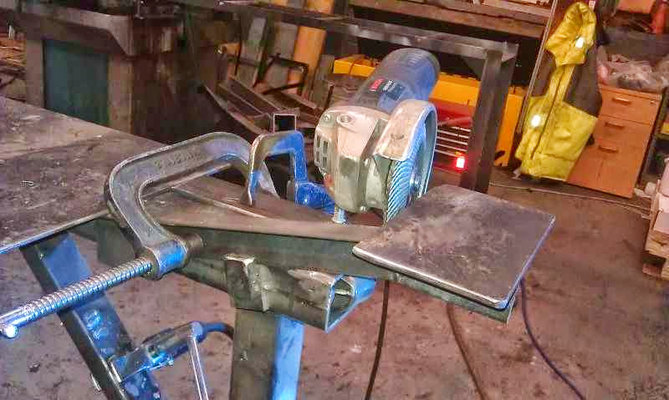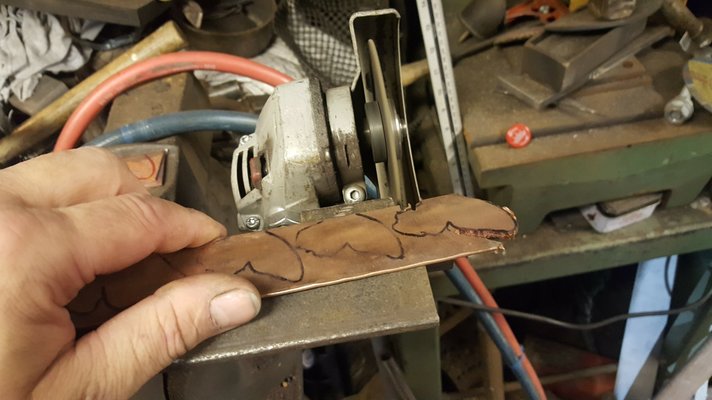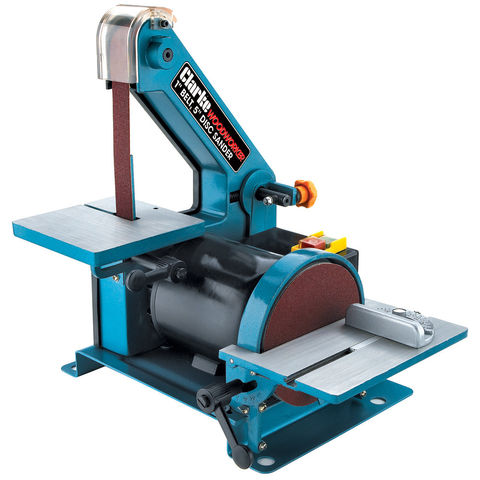rockweasel
Member
- Messages
- 995
- Location
- none
I'm ignorant, so all advice welcome.
Until now I've been using a grinding disc and a flap disc on an angle grinder to finish off the edges of steel plates or the ends of tubes and box sections. I've never managed to get that "machined" look that I'm after. The edges aren't flat. I'm not blaming my tools, I'm admitting that I don't have the skills to get the result with the tools I've got
I've started a new project this week that has me cutting out 4 profiles on sheet steel. I'm trying to get them all identical and closer to the machined look that I like. Of course when I roughly cut out the profiles and then ground the edges down to close to the desired size, they weren't smooth to the touch, so I this time I tried improvising a tool by clamping the angle grinder on it's side to the workbench at 90 degrees(ish) and offering up the steel sheet to it. Success ... to a degree. I could work on the outside edge of the piece, but I couldn't get the inner face flat again the grinder. It was also a bit scary to work on and I was wary of the steel catching and ripping away from my hand. I repeated the process with the belt sander on it's side and it made a nice job of finishing off the edges I could get at, and it was a bit therapeutic as well.
I started looking online for a tool that could do what I wanted and of course I had seen it a million times without the penny dropping as to what it was. I had a look on this forum for advice as well, but I thought I'd post a new thread specifically for what I'd use it for.
Attached is a photo of a couple of the profiles with a mug for scale. I've chalked the inner edge to indicate the faces that I'm having trouble grinding flat. My budget is around the £150. It would see light DIY use on wood and mild steel.
Thanks!!
(BTW thanks for the advice on transferring the CAD drawing to steel. After a couple of false starts I managed to stick it with a thin layer of wood glue and I'm happy with how much easier it made cutting the shapes)

Until now I've been using a grinding disc and a flap disc on an angle grinder to finish off the edges of steel plates or the ends of tubes and box sections. I've never managed to get that "machined" look that I'm after. The edges aren't flat. I'm not blaming my tools, I'm admitting that I don't have the skills to get the result with the tools I've got

I've started a new project this week that has me cutting out 4 profiles on sheet steel. I'm trying to get them all identical and closer to the machined look that I like. Of course when I roughly cut out the profiles and then ground the edges down to close to the desired size, they weren't smooth to the touch, so I this time I tried improvising a tool by clamping the angle grinder on it's side to the workbench at 90 degrees(ish) and offering up the steel sheet to it. Success ... to a degree. I could work on the outside edge of the piece, but I couldn't get the inner face flat again the grinder. It was also a bit scary to work on and I was wary of the steel catching and ripping away from my hand. I repeated the process with the belt sander on it's side and it made a nice job of finishing off the edges I could get at, and it was a bit therapeutic as well.
I started looking online for a tool that could do what I wanted and of course I had seen it a million times without the penny dropping as to what it was. I had a look on this forum for advice as well, but I thought I'd post a new thread specifically for what I'd use it for.
Attached is a photo of a couple of the profiles with a mug for scale. I've chalked the inner edge to indicate the faces that I'm having trouble grinding flat. My budget is around the £150. It would see light DIY use on wood and mild steel.
Thanks!!
(BTW thanks for the advice on transferring the CAD drawing to steel. After a couple of false starts I managed to stick it with a thin layer of wood glue and I'm happy with how much easier it made cutting the shapes)





